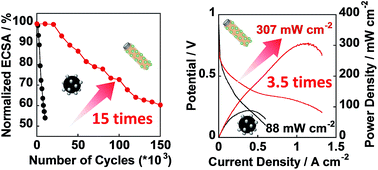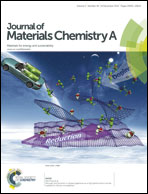Poly(vinylpyrrolidone)–wrapped carbon nanotube-based fuel cell electrocatalyst shows high durability and performance under non-humidified operation†
Abstract
Low durability and performance have limited the wide commercialization of high-temperature polymer electrolyte fuel cells (HT-PEFCs). In this study, we used an inexpensive commercially available polymer, poly(vinylpyrrolidone) (PVP), to coat multi-walled carbon nanotubes (MWNTs) and deposited platinum (Pt) on the PVP–wrapped MWNTs in order to fabricate a low-cost and durable fuel cell electrocatalyst. It was found that the synthesized fuel cell electrocatalyst showed high durability and performance under a non-humidified operation at a high temperature (120 °C). The synthesized electrocatalyst lost only ∼40% of the initial electrochemical surface area (ECSA) after 150 000 startup/shutdown cycles (from/to 1.0 to/from 1.5 V vs. RHE). The durability of the electrocatalyst was ∼15 times higher than that of commercial CB/Pt that lost ∼50% of its initial ECSA value after 10 000-potential cycles. Meanwhile, the membrane electrode assembly (MEA) fabricated from the synthesized electrocatalyst showed a high power density (307 mW cm−2) at 120 °C without any extra humidification, which was ∼3.5 times higher than that of the commercial CB/Pt (88 mW cm−2). Such results are of importance in fabricating an actual fuel cell catalyst.


 Please wait while we load your content...
Please wait while we load your content...